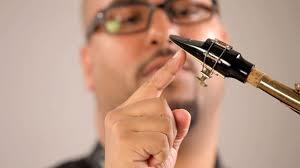
Many beginners of saxophone have a question: Why do I always have a crackling when playing? I have been very cautious when playing, but why can't I avoid the question? In fact, both beginners of saxophone and performers with some experience in playing can't avoid the problem of crackling. Sometimes even if your instruments and accessories are good, they can't avoid these problems. Therefore, beginners should not be too nervous. As long as we find out the cause of the crackling , actively try and adjust our own state, we can solve this problem.
Reed cause:
Many players will subconsciously think that there must be something wrong with the reed after the feedback occurs. In fact, if the reed of saxophone cannot vibrate regularly and evenly, there will indeed be crackling. Our usual performance of superelevation and overtone is the result of artificially controlling it, so we must not think that crackling is completely wrong. However, if we can't control the state of the reed well, it will really affect our daily performance.
Quick tip! Why is my reed crackling/distorting?:https://youtu.be/Rze8SJOwIxU
1. The use time of reed is too long

Because the reed of saxophone is usually made of natural materials, a reed have a service life. If you practice every day, you can usually replace a reed in about 10 days. If you practice less, you can use the reed for a longer time. However, because everyone's practice time is different, reeds need to be replaced in time when there are obvious sound changes.
At the same time, we can take out a reed that has been used for a long time for observation. At the bottom of the reed, especially the part directly touching the lips, there will be yellowing or unclean attachments. These attachments will affect the normal vibration of the reed. Therefore, we must clean the reed in time after practice to keep it dry and clean, which can also extend the use time of the reed.
2. The reed is too wet, too soft or not suitable for yourself
Many saxophone players are used to wetting the reed before using it, but in this part, it is prone to wet the reed too much, resulting in the reed being too wet and soft, which makes the reed lose its original hardness, and even a new reed will lose its original timbre and vibration.
There are also many beginners of saxophone who choose some thin or easy to play reeds for the sake of timbre or to save energy during performance, which will also lead to irregular vibration of the reeds and the phenomenon of crackling. Resin reed can solve the above problems, so you can choose according to your own needs.
Slade Alto saxophone plastic resin reed Strength2.5:https://www.sixmonthsrebellion.com/products/slade-alto-saxophone-plastic-resin-reed-strength25

Or you can purchase a box to place the reed in, this will keep the reed dry and protect the reed.
Personal reasons:
1. Mouth strength

We have already introduced the correct mouth shape when playing saxophone in the previous article, and I believe you have fully mastered it. However, many students still told me that it was too hard to keep the correct mouth shape. They felt that their mouth was always sore, especially the muscles around their lips felt like cramps.
If you have the above problems, you should train your mouth muscles! When playing saxophone, in addition to keeping the correct mouth shape, it is also important to have enough strength to support the performance, otherwise the mouth shape will be deformed, and the most common phenomenon is the downward turning of the lower lip due to lack of endurance.
We can try now. If our mouth is weak and the lower lip becomes loose or even the lower lip is unable to wrap the teeth on the reed, the teeth will directly touch the reed. You can take the initiative to try to play with your lower teeth directly biting the mouthpiece. No matter how hard you use, there will be crackling.
2. Position of mouth occlusion

When playing saxophone, we should pay attention to not only the strength of our mouth, but also our occlusion position. Generally speaking, we need to bite about 1/3 of the mouthpiece when playing saxophone, but many people will bite more because their mouths are weak, causing abnormal vibration of the reed. If you are still unable to determine the occlusion position, we can try to place a piece of paper between the installed reed and the mouthpiece. The stuck position is where we should bite.
If you are still unable to determine the position and strength of the occlusion, you can remove saxophone's bent neck from the instrument, and then try to experience it by heart. In this way, we can abandon other influencing factors and only focus on this problem. We can try to bite different positions for playing practice, and listen carefully to the sounds produced by different positions. Of course, the deeper we bite, the easier it will be to pop, because too much occlusion will cause insufficient vibration of the reed, which will lead to irregular vibration of the reed.





